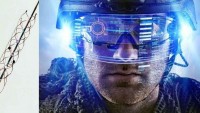Future American Soldiers will be True Cyborgs, Thanks to DARPA
| Arthur Dominic Villasanta | | Jun 17, 2016 08:22 PM EDT |
U.S. Army cyborg soldier
The brain machine interface (BMI) called a "stentrode" recently invented by Australian researchers with DARPA funding will be a critical step in transforming future U.S. soldiers into "cyborgs" that can connect directly to battlefield computers and "talk" to them "telepathically."
Like Us on Facebook
Giving U.S. soldiers, especially infantry, a huge tactical edge in future battlefields is precisely what the Neural Engineering System Design (NESD) program being implemented by the U.S. Defense Advanced Research Projects Agency (DARPA) intends to attain.
NESD's goal is to develop an implantable neural interface to bridge the formidable gap between the human brain and implanted digital devices. The implant DARPA has in mind pretty much sounds like the stentrode. DARPA said this device should give "unprecedented signal resolution and data-transfer bandwidth."
DARPA has specified an implantable device less than a single cubic centimeter in dimension as the end product of NESD. Stentrode is the size of a matchstick and can be implanted without the need for opening the skull.
The research that led Australian scientists at the University of Melbourne to the successful development of the stentrode this year was partially funded by DARPA.
Once perfected, the stentrode could allow U.S. soldiers to move and react faster on the battlefield and should eventually allow them to "talk to" and control futuristic mind-controlled weapons via the stentrode.
"The military appear interested in the potential for jet fighters to control their planes with direct thought control, rather than using their arms. The reaction time you'd shave off would be milliseconds," said Dr. Tom Oxley, the University of Melbourne Neurologist whose team has been working on the stentrode for over four years.
More specifically, DARPA wants U.S. Air Force pilots to control their jet fighters directly by plugging their brains into the aircraft's computer, said Dr. Oxley. The stentrode will make it possible for American fighter pilots to become true cyborgs.
Cyborg, a portmanteau for cybernetic organism, aren't the evil robots we've seen in the popular Terminator movies. A cyborg is a person with both organic and "biomechatronic" body parts.
A human cyborg such as a cyborg warrior has enhanced abilities because an artificial component such as the stentrode or technology that relies on some sort of feedback has been integrated into a part of his body such as the brain.
On the other hand, biomechatronics is a science that aims to integrate electronics and mechanical elements with living organisms.
In the case of American cyborg fighter pilots, the stentrode should help reduce pilot stress since flying computer-controlled aircraft such as the F-22 and F-35 is physically taxing and requires the pilot evaluate and monitor several actions occurring at once. Stentrodes could reduce pilot error.
With a BMI such as the stentrode, a fighter pilot's brain will send signals to the muscles in the pilot's hands to take instant action with the joystick when the pilot faces sudden danger. All without thinking.
The stentrode was developed by a team at the Vascular Bionics Laboratory at the University of Melbourne led by neurologist Dr. Oxley. The Australians plan to begin human trials of the device in 2017. They believe thought-controlled prosthetic limbs and wheelchairs activated by their stentrode might be available within a decade.
TagsDARPA, stentrode, Neural Engineering System Design, University of Melbourne, Dr. Tom Oxley, biomechatronics
©2015 Chinatopix All rights reserved. Do not reproduce without permission
EDITOR'S PICKS
-

Did the Trump administration just announce plans for a trade war with ‘hostile’ China and Russia?
-

US Senate passes Taiwan travel bill slammed by China
-

As Yan Sihong’s family grieves, here are other Chinese students who went missing abroad. Some have never been found
-

Beijing blasts Western critics who ‘smear China’ with the term sharp power
-

China Envoy Seeks to Defuse Tensions With U.S. as a Trade War Brews
-

Singapore's Deputy PM Provides Bitcoin Vote of Confidence Amid China's Blanket Bans
-

China warns investors over risks in overseas virtual currency trading
-

Chinese government most trustworthy: survey
-

Kashima Antlers On Course For Back-To-Back Titles
MOST POPULAR
LATEST NEWS
Zhou Yongkang: China's Former Security Chief Sentenced to Life in Prison

China's former Chief of the Ministry of Public Security, Zhou Yongkang, has been given a life sentence after he was found guilty of abusing his office, bribery and deliberately ... Full Article
TRENDING STORY

China Pork Prices Expected to Stabilize As The Supplies Recover

Elephone P9000 Smartphone is now on Sale on Amazon India

There's a Big Chance Cliffhangers Won't Still Be Resolved When Grey's Anatomy Season 13 Returns

Supreme Court Ruled on Samsung vs Apple Dispute for Patent Infringement

Microsoft Surface Pro 5 Rumors and Release Date: What is the Latest?












